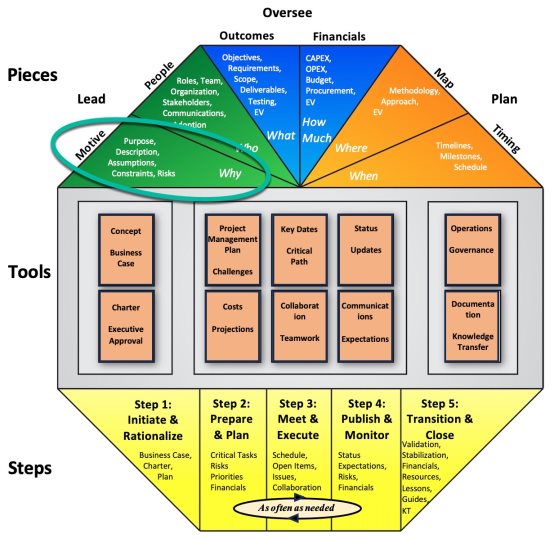1 Simple Way to Present Initial Project Risks
The purpose of this blog post is to cover a simple way to present project risks for awareness and support during the INITIATE and RATIONALIZE step of your project.
Risks are covered under INITIATE and RATIONALIZE when creating the Project Charter are under the LEAD domain and Motive segment.

Risks are covered under the LEAD domain and Motive segment
Identify and Communicate Project Risks
Reduce the Impact of Risks
In the vehicle purchase project we have featured in a few articles, you might spend time discussing a prospective model’s reliability and the potential for purchasing a lemon.

Keep an eye on, and document steps to mitigate, risks
Discussions about reliability and potential lemons are really centred around risk. While these examples are personal risks rather than business ones, your projects have issues that can present risks and need to be shared and discussed.
For more information about how the risks fit in with the initial definition of the project, see this article.
Two ways to represent risks
When you’re planning a project, you won’t be able to mitigate every risk. It’s more important to evaluate your risks and choose the ones that are likely to happen and present a large threat to your project’s success.
When evaluating risks, it's common to give them a score, weighted by multiplying some relative measure of how likely it is to occur by another relative measure of how great the impact is if it occurs. Higher numbers represent a more likely event and a greater impact.
Risk Score = How Likely (1=low to 5=high) x Impact (1=low to 5=high)
What it really comes down to, though, is looking at potential scenarios: if the issue happens, what problems can it cause, and what is the impact on your project or its outcomes?
Risk Statement = An Issue, if it occurs, can cause a Problem, leading to a negative Impact
Or
Risk Statement = An Issue, could have an effect, which causes an Impact

Risks are Issues that can cause a Problem with an Impact
Vehicle Purchase Project examples
For something like a personal project of a vehicle purchase, those effects can be personal.
For example, one risk could be stated as:
If you get a lemon, it could cause stress with extensive repairs or difficulty re-selling the vehicle later, leading to additional costs for you.
Another risk could be stated as:
If your vehicle does not meet your needs (ex. Camping or Skiing), it could cause a problem with your regular activities, negatively impacting your preferred lifestyle.
The questions above, where you are thinking about reliability and lifestyle fit as possible issues, the problems they can cause, and the impacts of those problems, are labeled as risks.
Once you’ve defined your risks and chosen the ones you will prioritize, each risk needs a mitigation strategy. In other words, a statement around the actions you’ll take to minimize the risk’s impact if it occurs or has a danger of occurring.
Initially specify risks using a simple statement
How to uncover types of Risks is covered in an upcoming blog article, but in summary, when you are in the INITIATE and RATIONALIZE step of the project and defining risks for your project charter, they can be stated as:
Issues, that if realized, cause a problem with a negative impact, for which it is beneficial to identify steps to mitigate the risk: and if we can’t mitigate the risk we need to have a plan of action to handle it if the risk occurs.
Phrasing Risks that way in your Project Charter avoids the needless math arguments that can occur, while still providing you a mechanism to present that you have considered constraints and challenges to your project.
You will also find that stating risks in this way connects more with executives so that is a good way to phrase them on status reports.
Summary
Risks are Issues, that if realized, can cause problems to your project or organization resulting in a negative impact.
Identify steps to mitigate the risk in case they occur or have a chance of occurring, so you have a plan of action.
Phrasing risks in a brief statement in your project charter simplifies the process and provides you a mechanism to present to your stakeholders that you have considered constraints and challenges to your project.
Action Steps / Apply This Knowledge
- List potential issues that could occur with your project.
- Choose a handful of the most important issues. Phrase these as Risks using Issue- leads to cause and potential Problem- leads to Impact. Try to keep it to a single sentence of about 40 words for each risk.

- For each risk, state some steps that could be followed to minimize the impact of the risk, should it occur.

- Prompt engineering guidance for AI GPTs such as chatGPT: I’m a business leader managing a project which is delivering X technology, in Y kind of organization. What are some potential risks that I should be identifying in the project charter, including some mitigations?”
Learn More to Do More
For Project Planning help download our free PDF.
Check out the learning hub which presents other project concepts from a project knowledge awareness standpoint: https://simplepmstrategies.com/learning-hub-index
INITIATE – Project Risks
© Simple PM Strategies 2024
